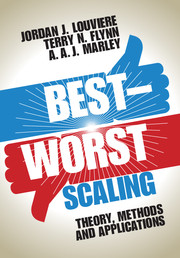Book contents
- Frontmatter
- Contents
- List of figures
- List of tables
- List of contributors to application chapters
- Preface
- Acknowledgments
- Theory and Methods
- 1 Introduction and overview of the book
- 2 The BWS object case
- 3 The BWS profile case
- 4 The BWS multi-profile case
- 5 Basic models
- 6 Looking forward
- Applications: Case 1
- Applications: Case 2
- Applications: Case 3
- References
- Subject index
- Author index
1 - Introduction and overview of the book
from Theory and Methods
Published online by Cambridge University Press: 05 October 2015
- Frontmatter
- Contents
- List of figures
- List of tables
- List of contributors to application chapters
- Preface
- Acknowledgments
- Theory and Methods
- 1 Introduction and overview of the book
- 2 The BWS object case
- 3 The BWS profile case
- 4 The BWS multi-profile case
- 5 Basic models
- 6 Looking forward
- Applications: Case 1
- Applications: Case 2
- Applications: Case 3
- References
- Subject index
- Author index
Summary
This book is written for researchers and practitioners who have minimal prior knowledge of best-worst scaling (BWS). Many readers will have experience with discrete choice experiments (DCEs), and to avoid making this a two-volume book we take some knowledge of that field as a given. However, the purpose is explicitly not to build a subdiscipline that is accessible only to a small number of practitioners who are already experts in a highly technical field. On the contrary, we wish to show that BWS is accessible to the average applied practitioner and that in many cases it can be successfully implemented using spreadsheets rather than statistical programs. However, to do this we will refer to ongoing methodological and cutting-edge theoretical work and will draw on methods and techniques used across several disciplines. Thus, while the book should enable any moderately quantitative practitioner to run a BWS study, academics interested in any non-routine application should have (considerable) cross-disciplinary experience with the methods: many important insights are gained only by experience, and the days of the generalist health/environmental/transport economist doing a DCE or BWS study are (or should be) numbered. Nevertheless, we hope to encourage practitioners with knowledge about discrete choice methods to apply BWS, as many of the design and analysis techniques are simple, though not part of the typical analytical “toolbox” taught to academics and practitioners.
1.1 A brief history of BWS
Best-worst scaling was developed by one of the authors (Louviere) in 1987 at the University of Alberta. Louviere was curious about what could be done with data that resulted from asking people not only to report the “top” choice in each choice set but the “bottom” choice as well. He constructed a small design and made a choice task to go with it, and asked Tulin Erdem, a PhD student at Alberta, to “do” the task. Tulin “did” the task, and brought it back asking what it was for and how it worked. Louviere told her that he had no idea how it worked, but thought that it could be a useful addition to choice experiments because it provided extra choice information. Crucially, it provided information about less attractive choice options and much more information about the respondent's value (utility) function. Louviere spent the next several years working on how to conceptualize such a task, and how to interpret and use the resulting data.
- Type
- Chapter
- Information
- Best-Worst ScalingTheory, Methods and Applications, pp. 3 - 13Publisher: Cambridge University PressPrint publication year: 2015

